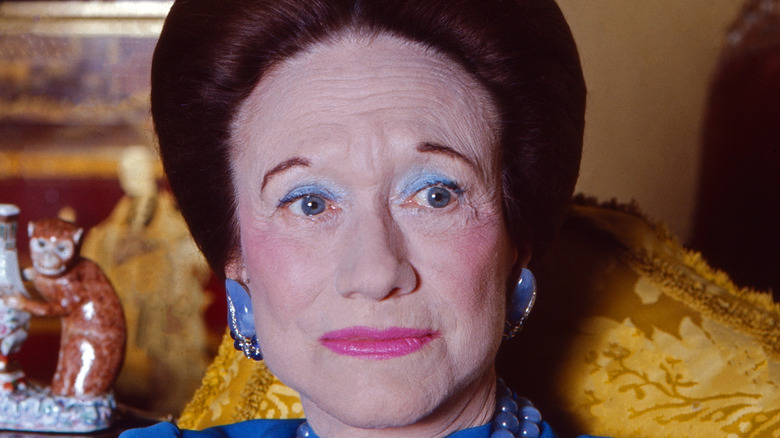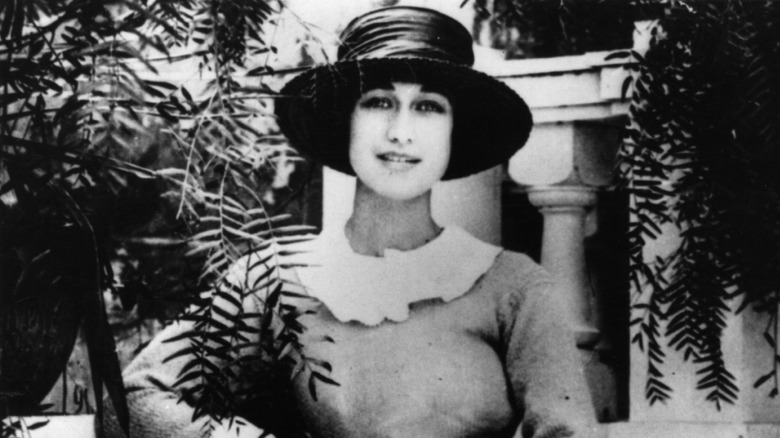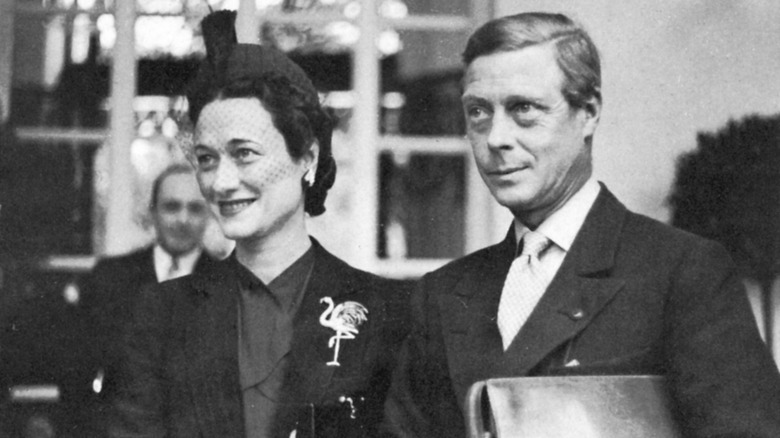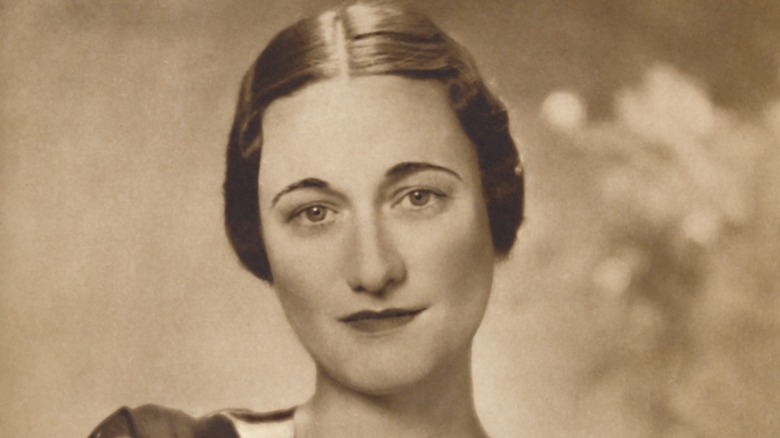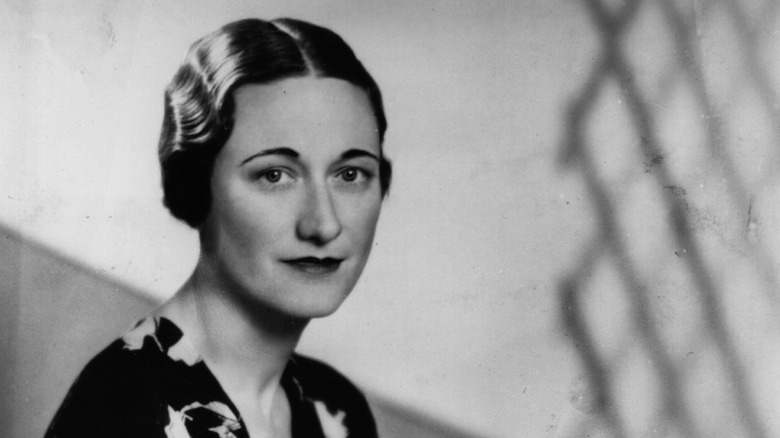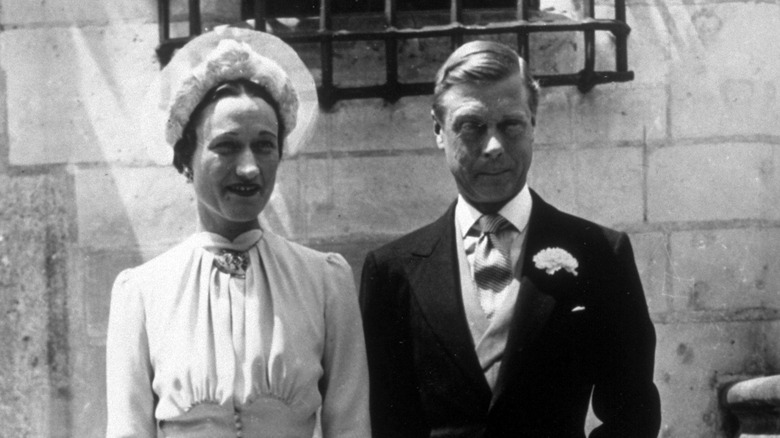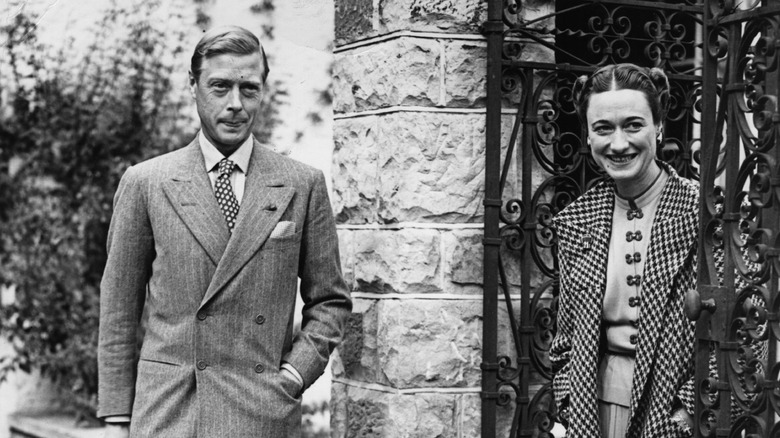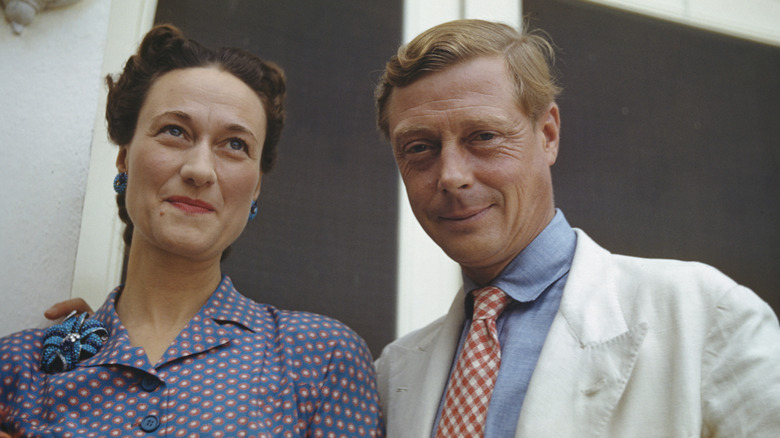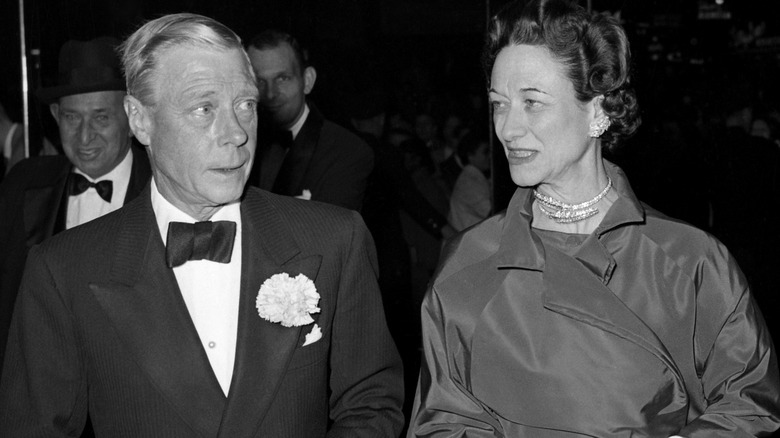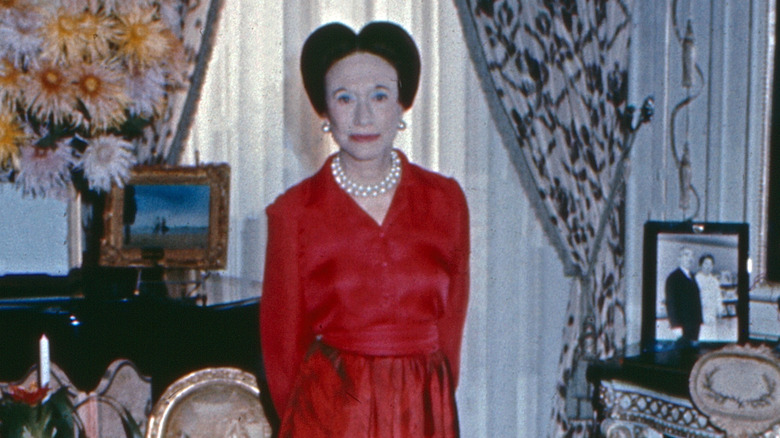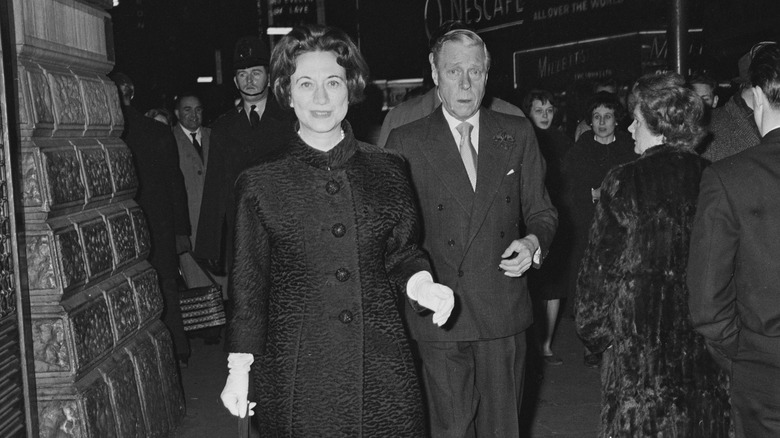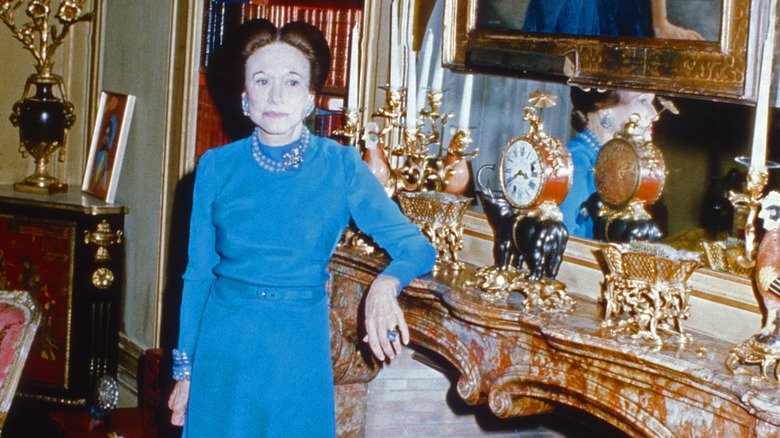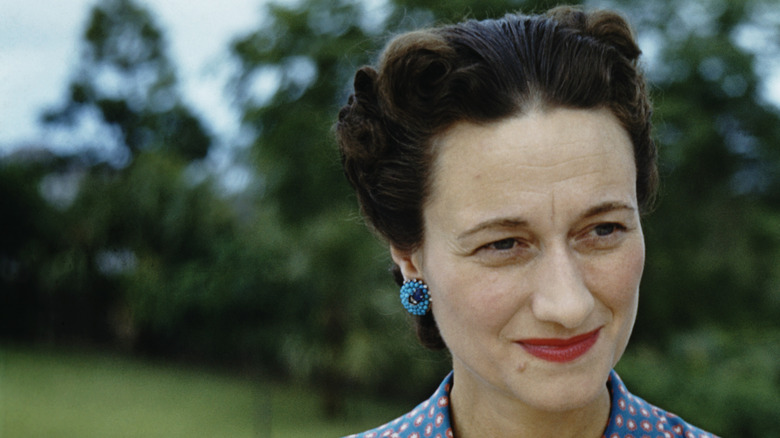What You Didn't Know About Wallis Simpson
During the 20th and 21st centuries, Britain's royal family introduced the public to an array of colorful personalities who have, for better or worse, left their respective marks upon the monarchy. While the modern era has been consumed with the scandal-plagued marriage of Prince Charles and Princess Diana — and, a generation later, the supposed rivalry between their sons, Prince William and Prince Harry — controversy has long been a hallmark of the House of Windsor.
Perhaps the most controversial figure within modern British royalty was neither British nor royal-born: It was likely Wallis Simpson, whose scandalous romance with King Edward VIII led him to abdicate the throne less than a year after becoming king.
Like much about British royalty, Wallis' story has been often told and meticulously re-examined over the years, creating a blend of fact and fiction in which what actually took place has become colored by myth. As a result, what most people think they know about the late Duchess of Windsor — who died in 1986 — only scratches the surface. To find out more about the woman who nearly brought the British monarchy to its knees, read on to discover the untold truth of Wallis Simpson.
She was twice divorced when she married Edward VIII
While Prince Charles' divorce and subsequent marriage to the also-divorced Camilla Parker Bowles wouldn't stand in the way of the Prince of Wales' eventual upgrade to King Charles, that was not the case during the brief reign of King Edward VIII in 1936. Divorce at that time was a big no-no for royals. According to Town & Country, the Church of England forbade the king from marrying a previously married woman whose former husband was still alive. This made his insistence on marrying Wallis Simpson a deal-breaker; not only was she American, but she had also been previously married — not once, but twice.
As Biography reported, the erstwhile Bessie Wallis Warfield married Navy pilot Earl Winfield Spencer Jr. in 1916. Spencer's alcoholism was just one of the problematic elements in their marriage, which ended in divorce in 1927. The following year, she married Ernest Aldrich Simpson, a British-American business executive, and the couple took up residence in London. During the course of her second marriage, she became romantically involved with the heir to the throne of England. She filed for divorce from Simpson in 1936, after Edward had become king.
Life after the abdication wasn't as glamorous as some thought
In his abdication speech, then-King Edward VIII famously declared he "found it impossible to carry the heavy burden of responsibility and to discharge my duties as king, as I would wish to do, without the help and support of the woman I love."
While the notion of giving up the throne for love may have seemed romantic, the reality wasn't quite the fairy tale some may have imagined. After their wedding, the former king and the American divorcee were given new titles — the Duke and Duchess of Windsor — and banished from England. The couple first lived in France, the New York Post reported, then spent the duration of World War II in the Bahamas, where the duke was made governor. After the war, they returned to France, where they lived for the rest of their lives, funded by a hefty royal allowance.
According to the Independent's review of Anne Sebba's 2011 biography "That Woman: The Life of Wallis Simpson, Duchess of Windsor," the later lives of the newly minted Duke and Duchess of Windsor were "aimless" and characterized by heavy drinking. Sebba quotes writer Lesley Blanch's description of the couple as "tiny twins with large bottles of drink."
Wallis Simpson was an object of hatred in England
During the time of King Edward VIII's abdication, Wallis Simpson was arguably the least popular person in England. As Simpson biographer Anne Sebba told NPR, she was "really loathed," with graffiti at the time reading, "Down with the American harlot."
While Simpson was depicted in the press as a temptress who lured the country's monarch to reluctantly renounce his throne, that portrayal was said to be both misogynous and one-dimensional — although Simpson didn't exactly go out of her way to counteract her image. "She was a very sexually threatening, dominant, rather vulgar, and ambitious woman," writer Tanya Gold told NPR. "And this is everything that the value system of the time despised."
In fact, the truth may have been somewhat murkier: The Duke of Windsor was thoroughly unsuited to be king, Gold explained, which exposed a glaring flaw in a constitutional monarchy in which sex and the order of birth — not ability — determines who will be monarch.
"And so rather than accept that this is a weakness of the system, it threw up a man who was essentially a mistake, an anomaly, a man who couldn't fulfill his duty," Gold explained. "Far better to say that he was stolen away by this evil woman."
She was Time's first Woman of the Year
It's not every American divorcee who finds herself at the center of the first royal abdication in British history — a fact that led Time magazine to put Wallis Simpson on the cover of its annual Person of the Year issue. Not only did she hold the distinction of being the magazine's most newsworthy person of 1936, but she was also the first woman to hold that particular honor.
As Time's entry about Simpson pointed out, she beat out a pretty impressive field of candidates, with the top four male contenders revealed to be British Prime Minister Stanley Baldwin, U.S. President Franklin D. Roosevelt, Italian dictator Benito Mussolini, and Chinese leader Chiang Kai-shek.
"It was an achievement last week that Mrs. Simpson was able for the first time to go shopping in Cannes without causing a crowd to collect," the magazine declared, noting that she ate Christmas dinner in a hotel. Simpson appeared "to drop from world publicity's most glaring spotlight to utter oblivion," which Time declared to be "the perfect 1937 exit for the Woman of 1936." However, as Time also pointed out, by the time Simpson appeared on the magazine's cover, her fame had already begun dimming.
Her wedding cake set a world record and wound up on Seinfeld
More than 60 years after Wallis Simpson married the Duke of Windsor, the couple made headlines when a slice of cake from their wedding sold at auction in 1998 for a whopping $29,900. The sale set a Guinness World Record as the most expensive slice of wedding cake of all time.
According to Guinness, the dessert — which was originally estimated to fetch between $500 and $1,000 — was purchased by Benjamin and Amanda Yin. When asked if he and his wife planned to place their slice of royal history on exhibit, Benjamin Yin quipped, "We're sure not going to eat it!"
Later that same year, the famed wedding cake turned up in Season 9, Episode 18 of "Seinfeld" in which Elaine (Julia Louis-Dreyfus) eats a slice, not knowing its provenance until too late. When her boss, Mr. Peterman (John O'Hurley) — who bought the cake at auction — busts her via security camera footage, he explains why he's not reprimanding her.
"Do you know what happens to a butter-based frosting after six decades in a poorly ventilated English basement?" he queries during the episode. "Well, I have a feeling what you are about to go through is punishment enough."
Wallis Simpson was suspected of being a Nazi sympathizer
Allegations of a pre-World War II dalliance led to lingering rumors that Wallis Simpson's sympathies lay not with Britain, but with the Third Reich.
As a BBC profile on Simpson recalled, the FBI investigated Simpson over her alleged relationship with Nazi foreign minister, Joachim von Ribbentrop, when he was ambassador to Britain in 1936. During the investigation, the FBI accused Simpson of passing him information.
According to The Guardian, a Benedictine monk with deep royal connections told the FBI that while von Ribbentrop was stationed in England, the foreign minister sent Simpson 17 carnations each day, symbolizing the 17 times they had allegedly been intimate. In fact, an FBI memo claimed that the British government had been so "fearful that the duchess will do or say some thing which will indicate her Nazi sympathies and support" that she and her husband were sent to the Bahamas during the war because "it was considered absolutely essential that the Windsors be removed to a point where they would do absolutely no harm."
As for a motive, an informant told the feds that Simpson had "an intense hate for the English since they had kicked them out of England."
Madonna directed a film about Wallis Simpson
Madonna is one celebrity who has held a long fascination with Wallis Simpson. Back in 2009, The Guardian reported that the entertainer was "passionate" about portraying Simpson in a film project she was shepherding into production. As news grew clearer about the film — titled "W.E." — it emerged that Madonna wasn't planning to star as Simpson, but would instead be directing, writing, and producing. In fact, Marie Claire reported that Madonna had written the queen requesting permission to make a story about Simpson's marriage to her uncle, while The Guardian claimed Madonna had sought out details from an actual royal, Princess Michael of Kent.
"I've found that if you bring up King Edward VIII and Wallis Simpson at a dinner party or a social gathering, it's like throwing a Molotov cocktail into the room," Madonna told the London Evening Standard of the fascination the couple still engendered. "Everyone erupts into an argument about who they were. I mean, they were very controversial — and continue to be. So, of course, I'm very attracted to that."
With a reported budget of $15 million, "W.E." was released in 2011. The film bombed at the box office with worldwide revenue of just $2 million.
The unflattering secret name she had for her husband
While the story of Wallis Simpson and the erstwhile King Edward VIII has been mythologized as a romance for the ages, the truth was far more complex. As Simpson's private letters (which form the basis of Anne Sebba's biography of Simpson, "That Woman: The Life of Wallis Simpson, Duchess of Windsor") made clear, it didn't take long before she began second-guessing her decision to divorce her second husband and marry the Duke of Windsor.
"None of this mess ... is of my own making," she wrote, as reported by The Independent. "It is the new Peter Pan plan," she added, using her private nickname for the former king, describing a boy who never grew up. Simpson spent the next 30-plus years living in luxurious exile, Sebba reported, trapped in a relationship she ultimately didn't want to be in.
"Nothing else in his life gave him any sense of achievement other than his marriage to Wallis," Sebba wrote of the duke, Politico reported. "For her, the slavish devotion was at times claustrophobic and she was not afraid to show it ... Few who knew them well described what they shared as love."
Wallis Simpson and her husband gave a headline-grabbing TV interview
In 1970, Wallis Simpson and her husband sat down with British journalist Kenneth Harris for an interview. Sitting among utter opulence within their posh Paris apartment, The Independent reported, the Duke and Duchess of Windsor — the former now going by the name "David" — appeared awkward and uncomfortable as they aired old grievances.
The Duke claimed to have "collided with the establishment," noted Tatler, while Simpson recalled all the hate mail she'd received. When asked if she regretted the path they'd taken, Simpson offered a diplomatic but telling response: "Oh about certain things yes," Simpson said. "I wish it could have been different but I'm extremely happy ... Naturally you've have had [sic] some hard times but who hasn't? You just have to learn to live with that."
As the Daily Mail recalled, 12 million viewers watched the interview in Britain alone — and while the utterances of the couple may seem banal and tame by modern standards, the interview caused quite the stir when it aired. As author Anna Pasternak wrote in The Daily Telegraph, the interview "seemed equally electrifying and scurrilous at the time, making headlines on both sides of the Atlantic."
She was allegedly in love with another man during her marriage to Edward VIII
Wallis Simpson's dissatisfaction with her marriage may have led her to fall in love with another man — at least that is the claim that author Andrew Morton makes in his book "Wallis in Love: The Untold Life of the Duchess of Windsor, the Woman Who Changed the Monarchy." As People reported, Morton's book alleges that she was in love with another man, Herman Rogers, before she wed the Duke of Windsor.
"Their relationship, I think, was very, very intimate," Morton said of Rogers — a former businessman and World War I officer — during an interview with CTV News. "When he remarried after his first wife died, Wallis said, 'He's the only man I've ever loved.'"
Her enduring love for Rogers, Morton explained, contributed to the sense of bitterness and resentment that Simpson felt about her marriage. "The book concerns [the Duke of Windsor's] infatuation and passion for her and her indifference to him and her love for someone else," Morton added. "It's kind of a post-modern fairy tale. There is no happy ending."
Wallis Simpson reportedly loved to humiliate her husband
By the 1950s, Wallis Simpson's marriage to the former king grew increasingly fraught. In his book "Wallis in Love: The Untold Life of the Duchess of Windsor, the Woman Who Changed the Monarchy," author Andrew Morton wrote that "the greatest love story of the 20th century" had deteriorated to the point where Simpson not only no longer loved her husband, she could barely tolerate him. As Simpson's friend Constance Coolidge once said, the Toronto Star reported, "Can you imagine a more terrible fate than to have to live up publicly to the legend of a love you don't feel?"
As Morton told CTV News, Simpson had a cruel streak. While she remained deferential to her husband in public, "once those lights were out, or those doors were closed, she was very different. He would often say to her, 'Am I going to go to bed in tears again tonight?'"
A report from the Daily Mail stated that Morton accused Simpson of engaging in "outrageous" dalliances apparently meant to "denigrate" the duke.
"She became rude, odious, and strange," said acquaintance Lady Gladwyn. "She spent all her time with effeminate young men, staying in nightclubs until dawn and sending the Duke home early: 'Buzz off, mosquito.'"
She had a sneaky trick to appear well-read
While Wallis Simpson was accused of many things during her life, by all accounts intellectual curiosity did not appear to be among them. According to USA Today's review of Anne Sebba's "That Woman: The Life of Wallis Simpson, Duchess of Windsor," former President John F. Kennedy's sister Kathleen Cavendish characterized Simpson as someone who "rarely thought seriously about anything except her next party, her next purchase of couture clothes or statement jewelry, her next cocktail."
Simpson was apparently not unaware of how people perceived her and devised a clever trick to make it appear as if she was far more well-read than she actually was during social situations. According to Andrew Morton's book "Wallis in Love: The Untold Life of the Duchess of Windsor, the Woman Who Changed the Monarchy" (as reported by the National Post), Simpson would read the first and last few pages of whatever the hot "book of the moment" happened to be, and would memorize a "relevant quote." As Morton wrote, Simpson would then use the quote she memorized as "an opening conversational gambit before going on to talk with insight and intelligence" about the book she hadn't actually read.
Wallis Simpson once shared her guide to entertaining
While Wallis Simpson may have been no literary scholar, she was not without a sense of humor. That came through in a 1949 issue of Vogue when the Duchess of Windsor wrote an article purporting to be her "guide to entertaining."
Along with ruminating on the Cold War, France's contribution to humanity (sauces, which she declares to be "manifestly the products of centuries"), and the differing dining habits of Americans and Europeans, Simpson offers a variety of tips for hosting a soiree. For example, she suggests 10 people as the "ideal number" for a dinner party, ensuring "a buried and contrasting company." Simpson also provides advice on how to rescue a dinner guest who, for whatever reason, is being excluded from conversation, and suggests alternating dining partners along with each course served.
She also dispels a common assumption. "The idea that everything can be left to a good chef is one of life's most dangerous illusions," she writes, warning of the hazards of leaving menu planning in the hands of a French chef who will unleash "a violent outpouring of sauces." Simpson concludes her missive by observing that "planning a party can be more fun than the party itself."
